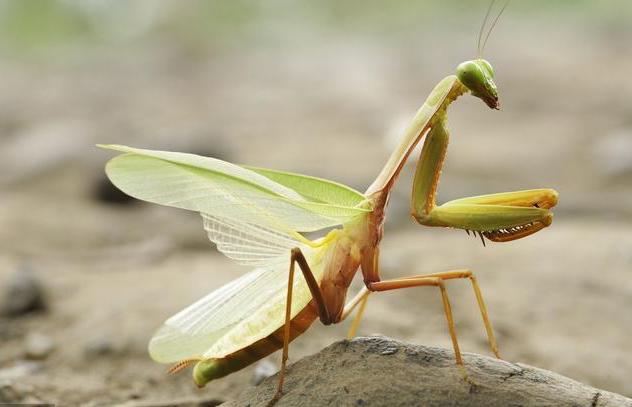Praying mantis (Mantodea) is an insect known for its ambush predation, known for its unique sickled forelegs, stealthy camouflage ability and flexible head movement. However, many people have doubts about the movement of praying mantises. Can praying mantises fly? In fact, the flying ability of praying mantises varies depending on the species, gender and individual development stage. This article will analyze the flying ability of praying mantises in detail from the aspects of body structure, wing function, flying method and ecological adaptability, and answer common questions about praying mantis flight.

Praying mantises are insects of the order Mantodea of the order Orthopteroidea. Most adults have two pairs of wings, but the shape and function of their wings vary from species to species:
Front wings (elytra): Harder, protecting the hind wings, similar to the elytra of beetles.
Hint wings (flight wings): Usually membranous, larger when unfolded, mainly used for flying.
Not all mantises have good flying ability, which is mainly affected by the following factors:
Gender differences: Male mantises usually have longer wings and stronger flying ability; female mantises have relatively short wings and weaker flying ability or almost no flying ability.
Species differences: Some mantis species have well-developed wings and can fly short distances, while some species have degenerated wings and cannot fly at all.
Development stage: Only adults have wings, and mantises in the larval stage are unable to fly.
In most mantis species, male mantises have longer wings and stronger flying ability, which is mainly related to reproductive behavior. Male mantises need to fly to find females for mating. For example:
Chinese mantis (Hierodula patellifera): Males can fly short distances, mainly for courtship and escaping natural enemies.
European Mantis (Mantis religiosa): Males have well-developed wings and are good at flying, especially at night.
Female mantises are usually larger and heavier, and have relatively short wings, which makes them less capable of flying. In most cases, female mantises can only glide short distances, or barely fly at all. For example:
Female Hierodula sp.: Short wings, usually only able to glide with the help of wings rather than actually fly.
Female orchid mantis (Hymenopus coronatus): wings are poorly developed, almost unable to fly, mainly relying on camouflage to catch prey.
The wings of some mantis species are completely degenerated, and both males and females are unable to fly, for example:
Ground mantis (Mantophasmatodea): wings are degenerated, relying on walking to move.
Ghost mantis (Phyllocrania paradoxa): although the wings are complete, the flying ability is extremely weak and it can hardly fly.
Mantises usually fly in a short straight line. They do not soar for a long time like butterflies or dragonflies, but mainly glide and flap short distances.
Some mantises (such as the European mantis) prefer to fly at night to avoid being discovered by daytime predators and increase the chance of finding females.
The mantis's ability to fly is also affected by environmental factors, such as:
When the temperature is too low, the mantis's muscle activity is limited and its flying ability is reduced.
When the wind is too strong, the mantis usually chooses to stay on the plant and will not take off easily.
Flight is a escape strategy for male mantises, for example:
When attacked by birds, lizards or spiders, male mantises can quickly fly away from the danger zone.
During mating, male mantises may use flight to escape predation by females (some female mantises will eat males after mating).
Although mantises mainly rely on ambush hunting, the ability to fly can help them:
Find new prey areas to avoid food resource depletion.
Move between different plants to increase the chance of prey capture.
The ability of male mantises to fly is crucial for finding mates, and they often need to cross long distances to find females for mating.
A mantis’s ability to fly depends on its species, sex, and wing development. Males usually have longer wings and are able to fly, while females are heavier and have shorter wings, so most cannot fly. In addition, some mantis species have completely degenerated wings, rendering them unable to fly.
No. Young mantises (nymphs) have no wings and rely mainly on walking and jumping to move. Only after emerging as adults can mantises become capable of flying.
The flying ability of mantises is far inferior to that of dragonflies. Dragonflies have two pairs of wings that can be controlled independently, which can hover, fly backwards, and even track prey at high speed, while mantises fly relatively slowly, mainly relying on gliding or short-distance flight.
The flying ability of mantises depends on species, gender, and physiological structure. Most male mantises can fly short distances, while female mantises usually have weaker flying ability or even cannot fly at all. Flying plays an important role in the survival of mantises, especially in escaping from natural enemies, finding food, and reproducing. By gaining a deeper understanding of the flying ability of mantises, we can better understand this unique insect and its ecological adaptability.
animal tags: mantises
We created this article in conjunction with AI technology, then made sure it was fact-checked and edited by a Animals Top editor.